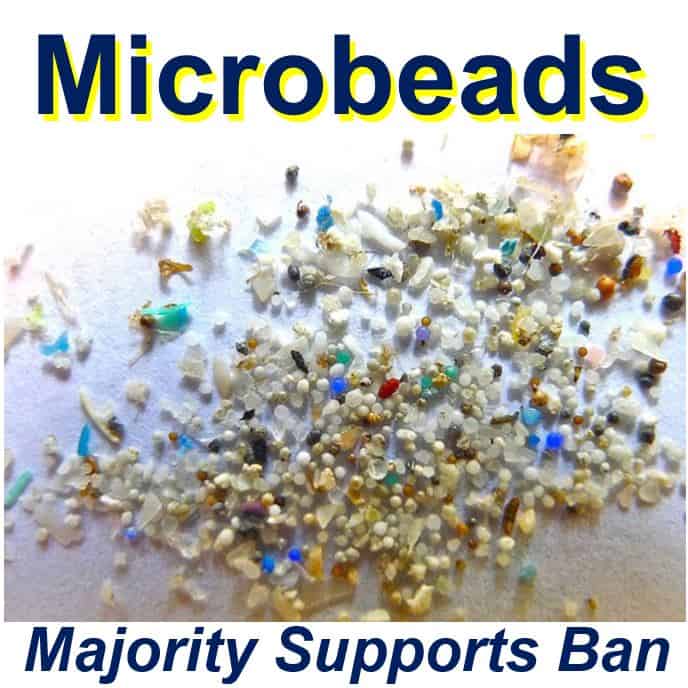Microbeads may be banned in the UK after the European Union said Britain can introduce legislation outlawing the tiny plastic particles. Experts had feared that Brussels might try to block any British ruling, claiming that it violated EU single market rules.
However, in a breakthrough on Friday, the European Commission said it was willing to allow a UK ban on plastic microbeads used in beauty products, toothpastes and shower gels.
Microbeads, generally made of polyethylene, and sometimes petrochemical plastics such as polystyrene and polypropylene, are minuscule microspheres – smaller than 5 millimeters in size – that are used extensively in cosmetics as exfoliating agents. They are also commonly found in toothpastes, shower gels, and used in biomedical and health science research.
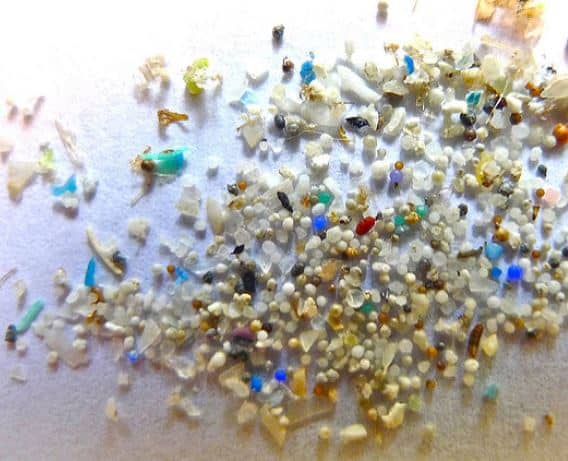 Microbeads are so tiny that they get through the filters in our sewage systems and pollute our rivers, lakes, canals and oceans. They end up in the stomachs of marine creatures, which many of us then eat. (Image: beatthemicrobead.org/en/photostream)
Microbeads are so tiny that they get through the filters in our sewage systems and pollute our rivers, lakes, canals and oceans. They end up in the stomachs of marine creatures, which many of us then eat. (Image: beatthemicrobead.org/en/photostream)
Microbeads used in personal care products are washed down the drain and end up in canals, rivers and the sea, resulting in serious plastic-particle water pollution. The particles are too small for filters to block and make their way into sewage treatment plants.
According to EU officials, Downing Street can introduce a ban under current cosmetic safety or environmental protection legislation if it demonstrates they are a danger to marine or human health.
Studies have demonstrated that after microbeads are flushed into canals, rivers and seas, they attract toxins, seriously undermine the health of marine life, and can eventually reach the human food chain – fish on our dinner table are contaminated with these tiny beads.
There is a safety clause in EU law that Britain could use to stop products containing microbeads being sold. As soon as the ban is introduced, the UK will be asked to justify why there is a threat to health, after which the European Commission will make an assessment.
 You can find microbeads all over the place, even on beaches and riverbanks. At the Virginia Institute of Marine Science, a team of scientists is currently trying to create biodegradable microbeads. (Image: Virginia Institute of Marine Science)
You can find microbeads all over the place, even on beaches and riverbanks. At the Virginia Institute of Marine Science, a team of scientists is currently trying to create biodegradable microbeads. (Image: Virginia Institute of Marine Science)
A commission spokesperson said:
“In the area of cosmetics, EU law foresees a safeguard clause which makes it possible for a member state to prohibit a product if it can justify that it presents a serious risk to human health.”
“A ban on certain substances on environmental grounds could also be compatible with the internal market.”
The UK is not the only EU member state planning to ban plastic microbeads. In July, France passed a law that will ban the sale of exfoliating cosmetic products containing solid waste particles from January 2018. Sweden is also in the process of introducing bans.
Since September 2015, cosmetics that contain plastic microbeads have been banned from sale in the city of Gothenburg, on Sweden’s west coast.
Baby fish hooked on plastic microbeads
Larval fish (baby fish) are addicted to plastic microbeads, which stunt their growth and raise mortality rates considerably, a group of scientists from Uppsala University in Sweden found.
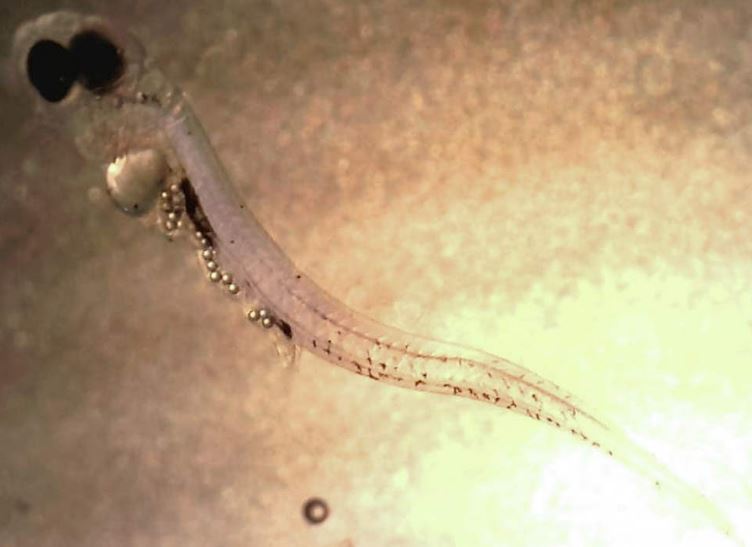 The tiny microbeads are clearly visibe inside this baby perch. Contaminated juveniles suffer from stunted growth, are considerably less active, and do not evade predators. (Image: sciencemag.org. Credit: Oona Lönnstedt)
The tiny microbeads are clearly visibe inside this baby perch. Contaminated juveniles suffer from stunted growth, are considerably less active, and do not evade predators. (Image: sciencemag.org. Credit: Oona Lönnstedt)
The developing juvenile fishes only ate plastic microbeads and completely ignored their natural food source – free swimming zooplankton – when given the chance.
The researchers said that these tiny plastic waste particles build up to high concentrations in the sea, especially in shallow coastal waters.
Oceans contaminated with more and more plastic
Ecologists and marine biologists are becoming increasingly concerned at how much plastic has accumulated in our oceans, and what the effect currently is and will be – because they build up – on marine ecosystems.
Peter Eklöv and Oona M. Lönnstedt explained in the academic journal Science that for the first time, they have been able to demonstrate that the development of larval fish is seriously affected by microplastic pollution.
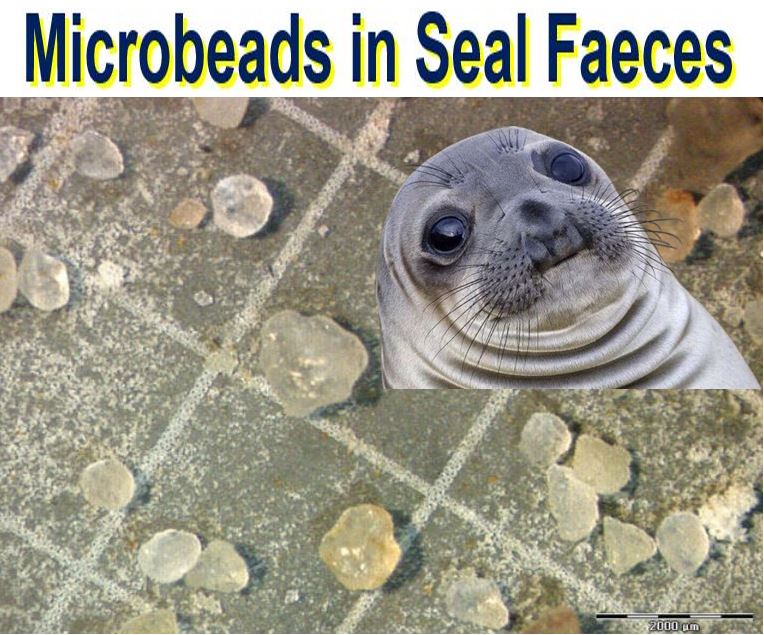 Microbeads have been found in the feaces of seals and several other marine animals. Scientists do not yet know how much remains inside the animals and to what extent it harms them. (Image: beatthemicrobead.org/en/photostream)
Microbeads have been found in the feaces of seals and several other marine animals. Scientists do not yet know how much remains inside the animals and to what extent it harms them. (Image: beatthemicrobead.org/en/photostream)
Dr. Lönnstedt, a post-doctoral researcher at the Department of Ecology and Genetics, Uppsala University, said:
“Fish reared in different concentrations of microplastic particles have reduced hatching rates and display abnormal behaviors. The microplastic particle levels tested in the current study are similar to what is found in many coastal habitats in Sweden and elsewhere in the world today.”
Larval perch that had been exposed to environmentally-relevant concentrations of microplastic polystyrene fragments displayed clear signs of stunted growth.
They also found that contaminated fishes lost their ability to evade predators and were considerably less active than their uncontaminated counterparts that had been reared in plastic-free water.
The contaminated juveniles did not react to the smell of predators like they should. Several experiments showed that predators, such as pike, soon gobbled all of them up because they kept swimming in front of them instead of hiding.
If mortality rates are higher and more of them get eaten by predators, the researchers suggest that their populations will probably decline.
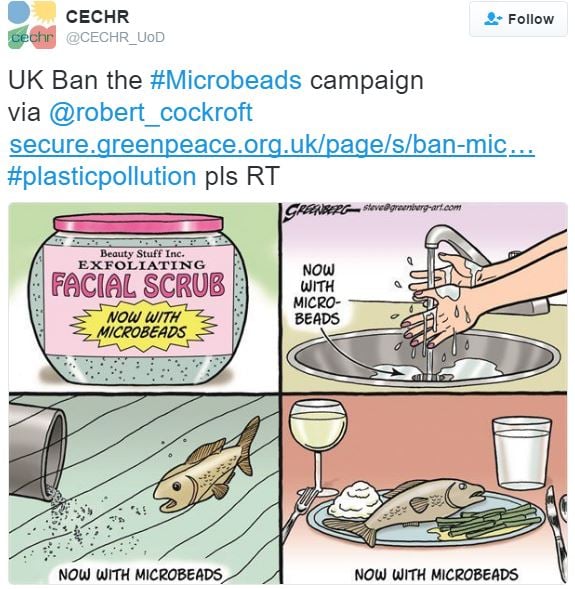 The Centre for Environmental Change and Human Resilience, based at Dundee University in Scotland, warns that the microbeads that end up in the sea, also end up back on our dinner plate! (Image: twitter.com/CECHR_UoD)
The Centre for Environmental Change and Human Resilience, based at Dundee University in Scotland, warns that the microbeads that end up in the sea, also end up back on our dinner plate! (Image: twitter.com/CECHR_UoD)
Prof. Eklöv said:
“Increases in microplastic pollution in the Baltic Sea and marked recruitment declines of the coastal keystone species, like perch and pike, have recently been observed. Our study suggests a potential driver for the observed decreased recruitment rate and increased mortality.”
Dr. Lönnstedt said:
“If early life-history stages of other species are similarly affected by microplastics, and this translates to increased mortality rates, the effects on aquatic ecosystems could be profound.”
What would humans do if certain types of junk food stunted the growth of their children, who also became much less active and started walking directly into oncoming traffic when crossing the road?
The dirty side of plastic #microbeads: used in beauty products, they often end up in the food chain. Listen: https://t.co/0YtMIISvQn
— BBC Business (@BBCBusiness) 24 August 2016
Majority of Britons support banning microbeads
A Greenpeace survey found that over 90% of Brits support banning the use of microbeads. Eighty-four percent of British consumers would be put off buying goods from a company if they were told it was extensively polluting our oceans.
According to Greenpeace, millions of tonnes of plastic waste ends up in our oceans each year. The global plastic waste problem affects us, because we eat contaminated fish.
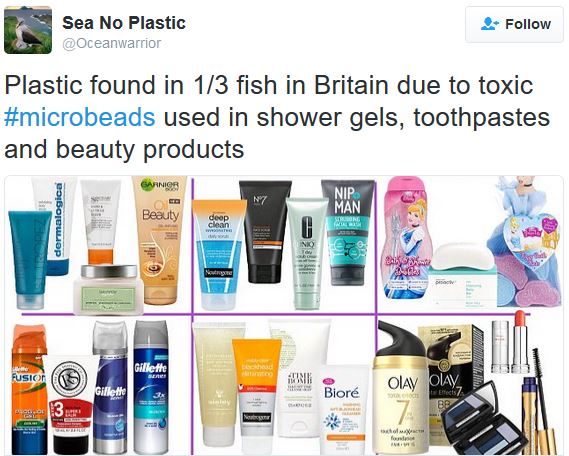 Most Britons have no idea that such a large proportion of fishes in our waters are contaminated with microbeads.
Most Britons have no idea that such a large proportion of fishes in our waters are contaminated with microbeads.
Beatthemicrobead.org made the following comment regarding face wash and microbead concentrations:
“Each recommended dollop for face wash can cause over 150,000 plastic beads to flood into the ocean. Chemist Sherri Mason found that the an average bottle of face wash can contain around 1.4 million microbeads.”
“Do not think you are safe from microbeads if you do not use an exfoliant face wash, they could very well be present in your toothpaste and body wash as well.”

